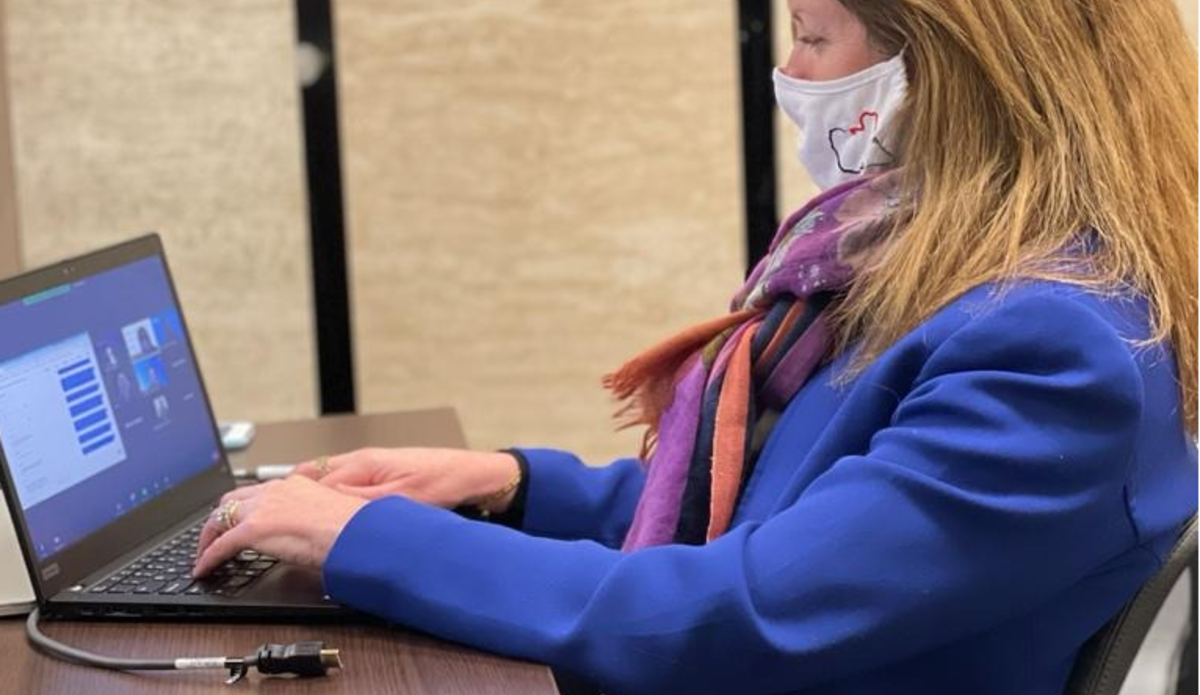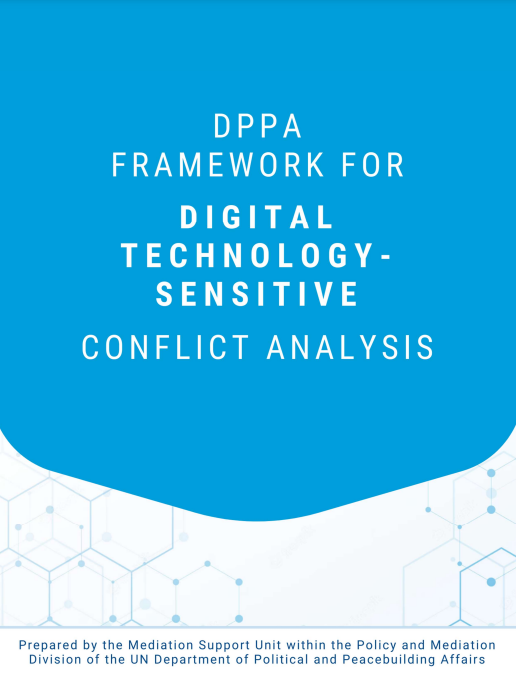Digital technologies present new opportunities for UN peacemaking efforts. At the same time, certain malicious uses of the technologies in conflict create new risks to collective peace and security. The Department of Political and Peacebuilding Affairs (DPPA) is undertaking several initiatives to deepen UN capacities in relation to leveraging digital technologies for peace and to develop preparedness to respond to the new challenges stemming from the use of digital technologies in conflict.
In 2019, the Mediation Support Unit and Centre for Humanitarian Dialogue published the Report on Digital Technologies and Mediation which assesses the opportunities and risks related to the use of digital technologies in four key areas of mediation practice: conflict analysis; engagement with the conflict parties; inclusivity; and social media and communication.
Today, MSU and its partners continue to deepen their efforts across these four priority areas and to support mediators on the ground in leveraging digital technologies in their daily work.
A risk management approach underpins our work in all of these priority areas. In leveraging digital technologies in conflict prevention and resolution, mediators need to acknowledge and manage new risks. The Digital Risk Management E-Learning Platform for Mediators aims to generate awareness of such risks and build the capacity of mediators to manage them.
Conflict Analysis
Digital technologies influence both the conduct and the content of conflict analysis
Digital technologies increase the volume, variety and velocity of information that can be gathered for conflict analysis. They also provide innovative means for managing and organising information. Data derived from digital sources should, however, be triangulated with other sources of information to ensure a more informed analysis. The United Nations and its partners are piloting different tools to increase the ability of peacemakers’ to analyse information on social media and generate reports.
Digital technologies are also changing the character of conflict as parties increasingly rely on them to advance their objectives. Mediators and their teams need to consider additional factors such as the digital ecosystem of a given setting and how digital technologies and related data issues influence the power dynamics of a conflict.
To address these new developments and help mediators and political affairs officers navigate the issues, the DPPA Policy and Mediation Division has prepared a Framework for Digital Technology-Sensitive Conflict Analysis.
Opportunities
- Low-cost, real-time and, increasingly, automated access to greater volumes and variety of information to support conflict analysis.
- Efficient tools to manage, organise and visualize information for conflict analysis.
- Real-time remote access to monitor developments on the ground, such as ongoing military activities, movements of populations or armed groups, for early warning or verification purposes.
- Enhanced capacity to identify sources/promoters of instability and violence, including hate speech, misinformation and disinformation.
Risks and challenges
- Lack of capacity and resources (human and technological) to manage, secure, analyze and contextualize significant volumes of information.
- Biased results based on algorithms reinforcing existing discriminations and exclusionary patterns or producing new ones.
- A false sense of informed decision-making.
- Mixed technical capacity to understand how conflict parties use digital technologies to support their positions and interests or compete for control of critical internet resources.
Engagement With Conflict Parties
Mediators increasingly rely on digital technologies to facilitate and sustain communications with conflict parties.
Face-to-face, in-person exchanges remain the most effective way to promote constructive relations and build trust with conflict parties and other stakeholders. Nonetheless, for numerous reasons, including distance, time, security and financial costs, many mediation teams view digital technologies as an important complement to traditional in-person forms of engagement. Today, mediators can rely on innovative and hybrid spaces for dialogue to complement in-person physical meetings.
DPPA is contributing to build the capacity of the UN security pillar to operate in conflicts transformed by the use of digital technologies. Since 2020, the Policy and Mediation Division, with the assistance of external experts, has run scenario exercises using a digital crisis management platform provided by the Geneva Centre for Security Policy, to train UN staff from HQ and the field and external experts on how to manage diplomatically ICT related security incidents.
Course on Digital Process Design and Facilitation
Digital technologies are transforming not just our life and our work but also the dynamics of politics and conflict. Mediation for the prevention and peaceful resolution of armed conflicts remains a human-centered endeavour in which personal interactions are crucial. Nevertheless, it is not immune from the technological changes which impact public life and inter-personal relations at multiple levels.
The Course on Digital Process Design and Facilitation helps mediators leverage the use of different platforms and tools for engaging and communicating with conflict parties.
Join the course now on Digital Process Design and Facilitation

Opportunities
- Enhanced communication and increased frequency and variety of interactions.
- Increased physical security and options for virtual interaction when face-to-face meetings are difficult or not possible.
- Reduced financial costs and logistical challenges for mediation teams and the conflict parties.
- Direct communication with decision-makers within the parties.
- Options for parties to work on documents in real time and from different locations.
- Timely communications and enhanced coordination with different regional and international stakeholders involved in a mediation process.
Risks and challenges
- Increased risk of misinterpretation of communications.
- The additional ‘noise’ stemming from interactions on social media can distract from or put pressure on conflict parties during negotiations.
- Reduced trust amongst those actors, who may prefer traditional modes of communication and traditional mediation techniques.
- Constant contact with, and increased pressure on negotiators from their constituencies.
- Breaches in confidentiality by the parties or the mediation team.
- Increased asymmetry between the parties in certain conflicts driven by factors such as access to digital technologies and critical internet resources, or the ability of the stronger party to intercept communications.
Inclusivity
Digital technologies offer a range of new means to include the perspectives of a wider group of stakeholders throughout the mediation process. They can also lower the costs and the logistical requirements of consultations.
Digital technologies – social media in particular – provide unprecedented opportunities for promoting greater inclusivity in a mediation process, provided, of course, that stakeholders have access to the internet. Importantly, they offer new opportunities for engaging and including the perspectives of different stakeholders, including women, youth and traditionally excluded or hard-to-reach groups, throughout the different phases of the mediation process.
The use of digital technologies to enhance inclusivity can also have the unintended consequence of perpetuating or creating new forms of exclusion. For instance, online consultative processes might unwittingly amplify existing discriminatory or exclusionary practices through the sampling process as well as cognitive and social biases introduced into the programming of the consultative tool from the outset. Furthermore, unequal access to the internet can deepen exclusionary patterns affecting women.
Online Course on Digital Inclusion and Women in Peace Processes
The publicly available course on women’s inclusion online focuses on the opportunities and risks of using digital technologies to enhance women’s participation in peace processes.
Opportunities
- Inclusion of views and perspectives of a greater and more diverse number of people, including from traditionally excluded or hard-to-reach groups.
- Online consultations can be less resource-heavy, safer and often more viable for local populations than referenda.
- Increased inclusivity without necessarily broadening the formal negotiating table.
- Online consultation mechanisms can be used as additional entry points in the event that a specific process is blocked.
- Increased capacity of parties through access to online resources information on peace-making and negotiation techniques.
Risks and challenges
- New forms of exclusion created by internet access and other resource barriers or algorithmic biases.
- More complex or overloaded processes, with unmanageable expectations, often amplified through social media interactions.
- Insufficient cybersecurity measures to protect the digital tools used for consultations, potentially leading to the identification of contributors and compromising their safety and security.
Communication and Social Media
Communications strategies help inform civil society and other stakeholders about developments in the peace process. Digital technologies have become essential to informing and delivering a mediator’s communications strategy.
Digital technology is increasingly used to support the development and implementation of a mediator’s public communications strategy. Understanding the digital ecosystem of a given context is crucial for determining which media to use to convey messages to which audience. Since traditional media still plays an important role in many conflict contexts, a public communications strategy should ensure it combines both traditional and electronic media so as to ensure consistency of messages.
For mediators, social media offers the potential not just for broadcasting information but for dynamic social engagement. Communication via social media presents challenges for mediators in terms of preserving the confidentiality of the process and avoiding a situation where polarizing online voices shape the narrative around a peace process.
Against this background, MSU and swisspeace teamed up for an evidence-based conversation about the impact of social media on peace mediation. The Social Media in Peace Mediation report summarizes the state of play, provides illustrative examples and makes practical suggestions for mediators and their teams.
Opportunities
- Provide access to a broader and more diverse audience on issues relating to the mediation process, including through the use of graphic material and photographic images.
- Provide a mediator with the opportunity to regularly update the public on developments in the process, and potentially counter spoilers.
- Key messages can be directed at target audiences and influencers to magnify their effect.
- Most social media companies have developed policies regulating what content is prohibited on the platform and how this is reviewed. All companies' policies include provisions regarding the incitement and promotion of violence. Most include regulations for hateful content, hate speech or generally harmful content, manipulated content, disinformation, and misinformation.
- Several third-party actors have developed tools to mitigate or counter hate speech, misinformation and disinformation.
Risks and challenges
- Misinformation and disinformation relating to the mediation process can expose mediators to criticism. Responding may have the unintended consequence of elevating accounts disseminating such narratives.
- Provide potential spoilers with additional means to influence public perception and impact a peace process.
- Social media companies continue to face technical, definitional, language, contextual analysis and normative issues in their efforts to moderate social media content.
- Third parties focused on flagging or countering hate speech, misinformation and disinformation continue to encounter technical, definitional and normative challenges.
- Insufficient cybersecurity measures to protect the digital tools used for consultations, potentially leading to the identification of contributors and compromising their safety and security.

